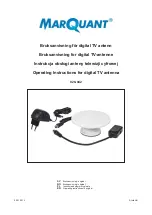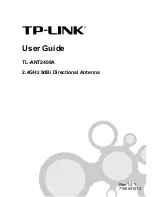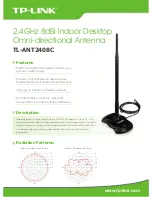
GPS 24XD HVS NMEA
®
0183
INSTALLATION
INSTRUCTIONS
Important Safety Information
CAUTION
Always wear safety goggles, ear protection, and a dust mask
when drilling, cutting, or sanding.
NOTICE
When drilling or cutting, always check what is on the opposite
side of the surface.
For the best performance and to avoid damage to your boat,
read all installation instructions before proceeding. Install the
device per these instructions. Use the appropriate fasteners,
tools, and mounts listed, which are available at most marine
dealers.
The Garmin
®
GPS 24xd HVS (NMEA 0183) high-sensitivity GPS
antenna provides position information over NMEA 0183. The
GPS 24xd can be connected to a Garmin chartplotter or another
NMEA 0183 compliant device.
For more information, go to
.
Tools Needed
• Drill
• 3.2 mm (1/8 in.) drill bit
• 19 mm (3/4 in.) drill bit for a pole-mount cable-hole
• 1 in. (25 mm) hole saw for a surface-mount cable-hole
• Countersink bit for mounting on fiberglass
• Screws for under-deck mounting
• Screwdriver, appropriate for the screw type
• Marine sealant (optional)
• Solder and shrink wrap for all wiring connections when
limiting the antenna to 1 Hz (
).
Mounting the Antenna
Antenna Mounting Considerations
CAUTION
Do not install or store the antenna near strong magnets,
including speakers. A strong magnetic field can damage the
antenna.
You can mount the antenna on a flat surface or attach it to a
standard 1 in. OD, 14 threads per inch, pipe-threaded pole (not
included). You can route the cable outside of the pole or through
the pole. For best performance, consider these guidelines when
selecting the antenna mounting location.
• To ensure the best reception, the antenna should be
mounted in a location that has a clear, unobstructed view of
the sky in all directions .
• The antenna should not be mounted where it is shaded by
the superstructure of the boat , a radome antenna, or the
mast.
• The antenna should not be mounted near the engine or other
sources of Electromagnetic Interference (EMI) .
• The antenna should not be mounted near known ferrous
metal objects such as a toolbox or compass.
• A handheld compass should be used to test for magnetic
interference in the area where the antenna is to be mounted.
Your boat, motors, and devices must be on during the test.
If the needle on the handheld compass moves when you hold
it where you intend to mount the antenna, magnetic
interference is present. You must choose another location
and test again.
• Mounting screws are provided with the antenna. If you use
mounting hardware other than the provided screws, the
hardware must be made of quality stainless steel or brass
material to avoid magnetic interference with the antenna.
NOTE:
Test all mounting hardware with a handheld compass
to make sure no magnetic fields are present in the hardware.
• If a radar is present, the antenna should be mounted above
the path of the radar . If necessary, the antenna may be
mounted below the path of the radar .
• The antenna should not be mounted directly in the path of the
radar .
• The antenna should not be mounted within 1 m (3 ft.) of a
VHF radio antenna or the path of a radar .
Testing the Mounting Location
1
Temporarily secure the antenna in the preferred mounting
location and test it for correct operation.
2
If you experience interference with other electronics, move
the antenna to a different location, and test it again.
TA-2020/6796
GUID-04C0F16F-F9A7-4EAC-96FC-C8DF7618E2D8 v2
November 2020
























